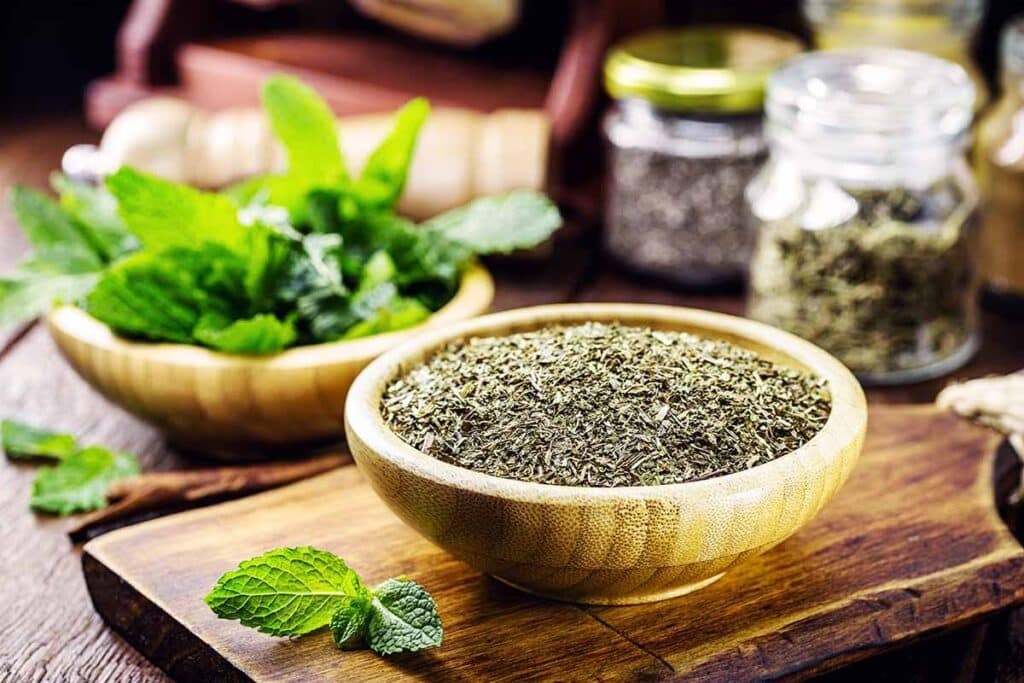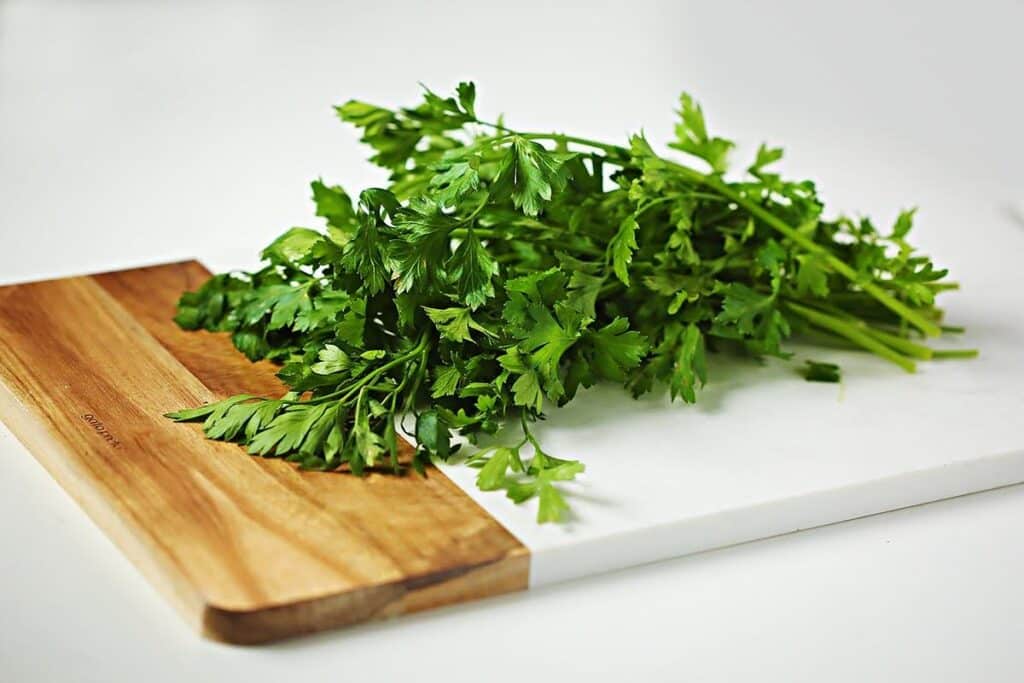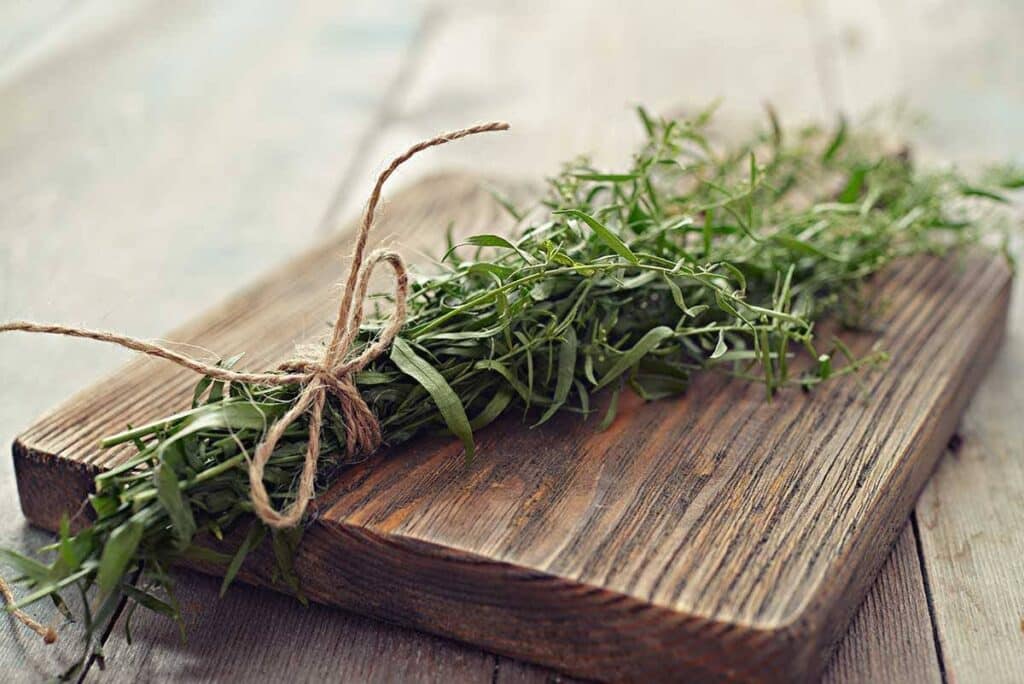Discover a refreshing substitute for mint in this article. We’ll present plenty of choices to breathe new life into your dishes.
From the refreshing zest of lemon balm to the pleasant basil flavor, we’ll take you on a journey into the world of the best mint swaps.

Mint refers to several herbs that fall under the genus Mentha.
In the culinary world, mint is known for its aromatic leaves and refreshing taste.
There are several types of mint, but the most popular are spearmint and peppermint. Lesser known varieties include apple mint, orange mint, and chocolate mint.
If your recipe calls for “mint,” it most likely refers to spearmint. Spearmint has a gentle minty flavor, which is unlikely to be overpowering.
If you find leaves labeled just mint in the supermarket, they’re probably spearmint. This herb offers a slightly sweet flavor.
Mint is a versatile ingredient you can use for both food and beverage.
It finds its place in salads and both sweet and savory dishes. You’ll also see them in recipes for cocktails, teas, and smoothies.
Because of their popularity, mint is very easy to find.
Most grocery stores have these fresh herbs available. Plus, people love planting them in their gardens for a quick stash.
Farmers’ markets are also good places to look for fresh mint bundles during the growing season. Of course, buying mint from online retailers is also a breeze.
There are several reasons why you might need a mint substitute.
Firstly, some individuals may have allergies or sensitivities to mint, making it essential to find alternative options for flavoring and aroma in recipes and beverages.
Additionally, if mint is unavailable or out of season, a substitute can provide a similar taste profile.
Here are the best mint substitutes for you to try.

You can use dried mint if your recipe calls for fresh mint leaves.
However, you have to note that dried mint has a different effect on food than fresh leaves.
It has a much more intense and pungent aroma and flavor, so using a lesser amount would be ideal.
This flavor intensity is also why it is not suitable for certain recipes that call for fresh mint. For instance, this hern is not great as a garnish.
Avoiding it in a mojito recipe is also best, as your drink won’t taste the same. You can use it, however, in cooking and baking.
The dried mint leaves will slowly release their essence as you cook them, perfectly infusing your food with their aroma and flavor.
Add it to baked goods, pasta, and casseroles. Dried mint is also perfect for meat rubs, chutney, and curries.
If you cannot find dried mint, look for mint tea bags instead. Cut open the tea bags to get access to the leaves. Do note that you should ensure you get pure mint tea, as some tea blends can include herbs other than mint.
Tips:
Use a teaspoon of dried mint leaves to replace a tablespoon of fresh mint.
Another excellent alternative for fresh mint is peppermint extract.
However, like dried mint leaves, there are only certain recipes in which the extract will work.
Peppermint has a similar minty flavor but is much spicier than spearmint. Plus, it comes in a liquid form.
It won’t be good for dishes that call for whole leaves. Instead, it works well in beverages and desserts.
Use peppermint oil or extract in baked goods, ice cream, or smoothies. It will provide the mint flavor to these foods effortlessly.
Tips:
Both peppermint extract and oil have a concentrated mint flavor. Start substituting mint leaves with a drop or two not to overpower other ingredients. Add more as necessary.
Lemon balm is another herb that comes from the mint family. As the name implies, lemon balm has a lemony aroma and flavor. However, it also boasts a menthol taste, just less intense than spearmint.
With that similarity, it can be a substitute for mint. You can use it anywhere you need fresh leaves. It works wonderfully as a garnish, as it looks similar to mint.
Adding this to dishes, though, will introduce citrus notes to the recipe. That said, using lemon balm instead of mint can alter the flavor profile of your dish.
For this reason, this is not the best choice if you dislike citrus flavors or want to maintain the original taste of the recipe.
Tips:
Use the same amount of lemon balm to replace mint. If you think lemon balm lacks the refreshing mint flavor, add one drop of mint extract to your dish to compensate.

For another excellent mint substitute, check out lemon verbena. At first look, this herb won’t qualify as a swap for mint. It does not look like mint. Rather, it has elongated and thin leaves, which makes the swap recognizable.
However, the flavor of lemon verbena is impressive, offering a strong lemon-like taste, even stronger than that of lemon balm. That said, it will make your dish very citrusy.
While this strays away from the minty flavor, it still can refresh your dishes. Plus, lemon verbena is a perfect alternative for people who dislike the menthol flavor of mint.
The great thing about this herb is that it goes well with sweet and savory recipes. It also makes for a wonderful beverage ingredient, may it be tea or smoothie.
Despite it having a different appearance compared to mint, the leaves are pleasant enough to become garnishes.
Tips:
Use half the amount of lemon verbena to replace each part of mint your recipe calls for.

If a fresh flavor is the only thing your dish needs, then basil is an excellent alternative to mint. It’s aromatic and refreshing, only it does not have that familiar menthol touch from the mint.
The great thing about basil is that it is a common herb. It is widely available; people love it for the classic pesto recipe. The herb is also among the most popular plants in their gardens.
Do note that fresh basil comes with a peppery flavor to your dishes, along with a subtle sweetness. It will significantly change how the dish tastes.
For this reason, basil won’t work in every recipe that calls for mint. It does work for mojitos and smoothies.
However, for dishes that get their main flavor from mint, you are better off skipping basil if you want to stay close to the original taste.
Tips:
You may need to use more basil than the amount of mint your recipe calls for to get a similar flavor intensity. However, if you’re using it for the first time, starting with a 1:1 substitution ratio is best. Just add more as necessary.

If you’re looking for a substitute for mint just so your dish won’t lack the green hue, parsley is a decent choice.
Parsley has a pleasant aroma, along with a subtle taste. It will add some hints of peppery and earthy notes to your dish. Still, these flavors won’t affect the taste of your dish too much.
After all, they’re not strong and overwhelming. Instead, they make the herb versatile, enabling them to pair well with many other ingredients.
However, due to its earthy flavor, it is best to avoid using parsley for desserts and other sweet dishes.
Use it in savory recipes like salads, soups, and stews. Surprisingly, parsley is also a good ingredient for a smoothie.
Tips:
There are many varieties of parsley you can choose from. If you’re all about the subtle flavor, go for flat-leaf parsley. Use a 1:1 substitution ratio.

Tarragano is an herb that has a licorice-like flavor. We all know that the licorice taste is not everyone’s favorite, so you may have to think twice about this swap.
If there is a slight chance that any of your guests do not like licorice, it may be better to skip this swap.
However, for people who like that particular taste, tarragon is another option for a mint substitute.
While it is true that tarragon does not taste like mint, it does offer a refreshing effect. Its inclusion in your dish can elevate its taste, not in the same way as mint does, but nevertheless in a pleasant way.
Tarragon is a great replacement for mint in drinks, both for teas and smoothies. It is also perfect for savory dishes, including salads and sauces.
Tips:
Due to the difference in flavor, it’s best to use tarragon in half the amount of mint your recipe requires.
Cilantro is an ingredient that’s just like licorice in a way that some people swear by it while others despise it. It tastes like a combination of lemon and pepper and is citrusy and slightly spicy.
Due to this flavor profile, it can add a fresh taste to both drinks and food. For this reason, it can be a viable substitute for mint in some recipes. You should not expect the same intense mint flavor, though.
You have to remember that cilantro has a strong and pungent flavor. It can easily overpower your other ingredients and steer the taste of your dish away from its original flavor.
Cilantro works great as a mint swap in a mojito mix. You may also use it in salads and other savory dishes that call for mint. Avoid it for desserts for the best results.
Tips:
Use only half the amount of cilantro as you would mint. This way, you can achieve a balanced taste.
Did you know that oregano, the fragrant herb we love in our Italian seasoning blend, comes from the same family as mint? If not, then now you know!
Because they come from the same family, oregano and mint share similarities. That said, oregano is among the best swaps for mint.
Oregano has no minty taste, so don’t expect that same zing. What oregano offers is a robust earthy and savory flavor, which can enhance the flavor of your food like mint does.
Use it in place of fresh chopped mint rubs and marinades, as the oregano flavor pairs well with fish, lamb, and beef.
Tips:
Cut the amount of mint your recipe needs in half to determine how much oregano you should use.
Lemon balm is an herb that is very similar to mint. It has a similar minty flavor; after all, it hails from the same family as spearmint and peppermint.
This herb has a milder flavor than mint and comes with citrus notes. Still, this herb is among the best mint substitutes.
Nevertheless, you can use lemon balm to replace mint in most recipes, following a 1:1 ratio.
In a cocktail, among the best substitutes for mint are lemon balm, basil, and cilantro. They will leave your drinks with a menthol-like taste and a pleasant aroma.
In cooking, people use mint as a flavor enhancer for both sweet and savory dishes. Mint is also useful in meat rubs and marinades, infusing proteins with a refreshing flavor and a lovely aroma.

There is no need to worry if you’re in need of a substitute for mint. After all, plenty of fragrant herbs are here to save the day. Dried mint is an excellent swap for the fresh herb in cooking and baking, while peppermint extract or oil does the job for drinks and desserts.
Lemon verbena, basil, and parsley are great options for mint replacement. Tarragon’s licorice-like flavor is refreshing enough to be a worthy alternative to mint, too. In a pinch, you may also use cilantro and oregano. With this many options, you can freely choose the herb that suits your taste. You can enjoy your dishes and drinks even without mint.






